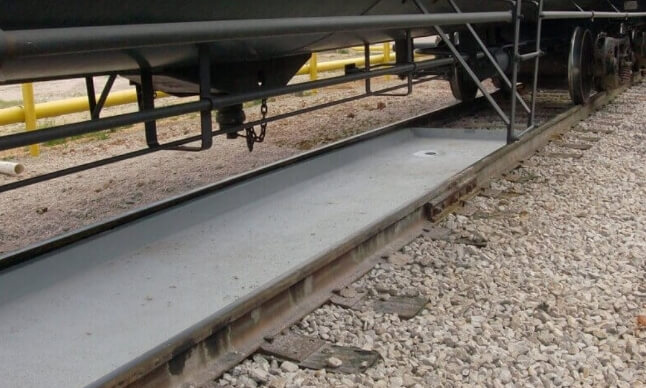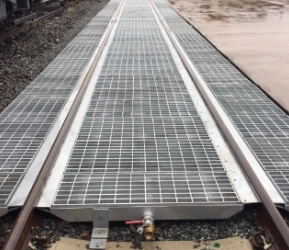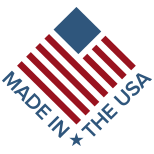Call Us: 1.800.275.3453
Request a QuoteCall Us: 1.800.275.3453
Request a Quote
Railroad track pans are a critical part of spill prevention systems, ensuring safe and sustainable rail operations. Designed to capture leaks, drips, and spills from railcars, these containment systems protect the environment and businesses from the risks of hazardous material spills. For industries such as chemicals, fuel transport, and manufacturing, railroad track pans provide an essential safeguard against soil and water contamination.
In this Article:
Railroad track pans are specialized spill containment systems installed between or beneath railway tracks. Their primary function is to collect and contain hazardous liquids such as fuel, oil, or chemicals that may leak during railcar loading, unloading, or maintenance operations. Made from durable materials like fiberglass-reinforced plastic or high-density polyethylene, these systems are engineered to withstand harsh environmental conditions and the mechanical stress of train operations.
Track pans typically feature a modular design, making them adaptable to various track configurations. They include features like grating covers for safe foot traffic, drain connections for efficient liquid removal, and optional liners to enhance chemical resistance. By capturing and containing spills, railroad track pans play a pivotal role in preventing environmental contamination and maintaining compliance with regulatory standards.
One example of an innovative railroad track pan system is Polystar Containment’s Star Track®, a modular, composite track pan designed specifically for railroads. This system effectively contains spills during railcar operations, ensuring environmental protection and regulatory compliance.
The Star Track® is engineered with a durable, lightweight design that simplifies installation while providing robust chemical resistance. It also features an integrated sump for efficient liquid management and optional track covers for enhanced safety. With its adaptability and high-performance materials, Star Track® offers an ideal solution for railcar spill containment pans in a wide range of industries.
Railroad track pans function as a containment system strategically positioned beneath railcars. Their design allows them to effectively collect and retain hazardous liquids that may leak or drip during railcar operations. Here’s how they work:

By incorporating these mechanisms, track pans help ensure that railcar spill containment is both effective and efficient, safeguarding the environment while promoting operational safety.
The importance of railroad track pans lies in their ability to mitigate environmental risks and support compliance with stringent regulations. Here are the key reasons why they are essential:
Railcar spill containment systems like track pans prevent hazardous liquids from seeping into the soil or waterways, reducing the risk of environmental contamination. This is a critical safeguard for industries transporting chemicals, fuel, or other pollutants.
Railroads are subject to strict environmental regulations, including Spill Prevention, Control, and Countermeasure (SPCC) requirements. Railroad track pans help businesses meet these standards, avoiding hefty fines and legal repercussions.
Investing in track pans minimizes the financial impact of spill-related cleanup efforts, liability claims, and potential downtime due to environmental violations.
By providing an easy-to-maintain solution, railroad track pans streamline spill management during railcar operations. This reduces delays and enhances overall railroad track maintenance practices.
Incorporating spill containment systems like track pans demonstrates a commitment to sustainable operations, which can improve public perception and strengthen relationships with stakeholders.
This combination of benefits underscores why railroad track pans are a vital tool for maintaining safe and efficient rail operations.
Selecting the right railroad track pan involves assessing your facility’s specific needs and ensuring compatibility with your operational requirements. Here are some key factors to consider:
Choose track pans made from materials that are resistant to the chemicals or liquids your facility handles. Options like fiberglass-reinforced plastic or high-density polyethylene are durable and offer excellent chemical resistance.
Consider the volume of liquids that may need to be contained. Ensure the track pans you select can handle potential spills, drips, and leaks during railcar operations.
For facilities with unique or variable track configurations, modular track pans offer flexibility. These systems can be customized to fit different track lengths and layouts.
Opt for track pans with features like drain ports, liners, or grating covers to simplify cleanup and ensure efficient operation during routine railroad track maintenance.
Ensure the track pans meet industry standards for spill containment and regulatory compliance, such as SPCC requirements. This is essential to avoid penalties and maintain safe operations.
By considering these factors, you can select a railroad track pan system that enhances safety, protects the environment, and meets your operational goals.
When it comes to selecting and using railroad track pans, you might have some important questions about their functionality and compliance. Below, we’ve addressed some of the most common inquiries to help you make informed decisions for your facility.
Visit our railroad spill containment solutions page to explore our full range of track pan systems and learn how we can help safeguard your operations. Ready to take the next step? Contact us today to discuss your containment requirements and find the perfect solution for your facility.
Request a QuoteWhen it comes to selecting and using railroad track pans, you might have some important questions about their functionality and compliance. Below, we’ve addressed some of the most common inquiries to help you make informed decisions for your facility.
While specific regulations may vary by location and industry, railroad track pans are often necessary to comply with environmental protection standards such as the Spill Prevention, Control, and Countermeasure (SPCC) rule. These systems are essential for preventing hazardous materials from contaminating soil and water, ensuring businesses meet regulatory requirements.
The capacity of a railroad track pan varies depending on its size and design. Modular systems can be configured to meet specific containment needs, ranging from small leaks to large-scale spills. Manufacturers like Polystar Containment can provide detailed specifications to ensure the system meets your requirements.
Yes, most railroad track pans are designed to withstand extreme weather conditions, including heavy rain, snow, and high temperatures. Durable materials like fiberglass-reinforced plastic and high-density polyethylene ensure reliable performance and longevity, even in harsh environments.
Maintenance frequency depends on usage and the types of materials being contained. Regular inspections for damage, buildup, or leaks are recommended, along with periodic cleaning to remove any residue and ensure proper functionality.
Many railroad track pans, such as modular systems, are designed for easy installation. They often come with detailed instructions and require minimal tools, making them a practical choice for facilities needing quick deployment and reliable spill containment.
